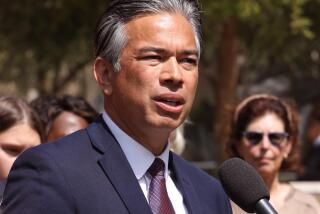INS to Restrict High-Speed Border Chases
- Share via
U.S. immigration authorities, harshly criticized after a Border Patrol chase led to a crash that killed six people outside a Temecula high school, are tightening restrictions on high-speed pursuits, greatly limiting agents’ discretion.
The new policy, announced Friday in Washington, prohibits agents from embarking on high-speed pursuits unless four safety criteria are met.
Border Patrol officials will be required to terminate chases when, in the judgment of officers or their supervisors, “the danger posed to the public, the officers or the suspect is greater than the benefit of apprehending the suspect.”
The revised guidelines will probably not go into effect for several weeks, until field offices and agents nationwide have been briefed, said Virginia C. Kice, spokeswoman for the Immigration and Naturalization Service. Officials are formulating operating instructions, Kice said.
The action comes at a time when the Border Patrol--a uniformed enforcement arm of the INS--is facing scrutiny after the June 2 Temecula incident, in which a van smuggling illegal immigrants crashed while fleeing a Border Patrol vehicle, killing six people.
The tragedy sparked outrage in the fast-growing Riverside County suburb and throughout California, where Border Patrol chases have claimed at least 21 lives since 1980.
Two congressional panels are scheduled to hold hearings within the next few weeks to examine Border Patrol policies. Lawmakers will examine the revised policies and may seek additional restrictions, said Rep. Al McCandless of La Quinta, ranking Republican on the government operations subcommittee on information, justice and agriculture.
Under the revised guidelines, agents may initiate high-speed chases only if suspects avoid arrest by driving vehicles at excessive speeds or commit other hazardous moving violations; drivers refuse to stop at officers’ commands; suspects “would present a danger to human life or cause serious injury, and the officers notify communications personnel.
More to Read
Sign up for Essential California
The most important California stories and recommendations in your inbox every morning.
You may occasionally receive promotional content from the Los Angeles Times.













